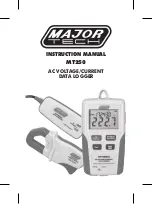
10-2
|
ni.com
Chapter 10
Bus Interface
–
Counter 1
–
Digital waveform generation (digital output)
–
Digital waveform acquisition (digital input)
Each DMA controller channel contains a FIFO and independent processes for filling and
emptying the FIFO. This allows the buses involved in the transfer to operate independently
for maximum performance. Data is transferred simultaneously between the ports. The
DMA controller supports burst transfers to and from the FIFO.
Each DMA controller supports several features to optimize PCI/PXI bus utilization. The
DMA controllers pack and unpack data through the FIFOs. This feature allows the DMA
controllers to combine multiple 16-bit transfers to the DAQ circuitry into a single 32-bit
burst transfer on PCI. The DMA controllers also automatically handle unaligned memory
buffers on PCI/PXI.
•
Interrupt Request (IRQ)
—IRQ transfers rely on the CPU to service data transfer requests.
The device notifies the CPU when it is ready to transfer data. The data transfer speed is
tightly coupled to the rate at which the CPU can service the interrupt requests. If you are
using interrupts to transfer data at a rate faster than the rate the CPU can service the
interrupts, your systems may start to freeze.
•
Programmed I/O
—Programmed I/O is a data transfer mechanism where the user’s
program is responsible for transferring data. Each read or write call in the program initiates
the transfer of data. Programmed I/O is typically used in software-timed (on-demand)
operations. Refer to the
Analog Output Data Generation Methods
section of Chapter 5,
Analog Output
, for more information.
Note
On PCI, PCI Express, PXI, and PXI Express M Series devices, each
measurement and acquisition circuit (that is, AI, AO, and so on) has a dedicated
DMA channel. So in most applications, all data transfers use DMA. However,
NI-DAQmx allows you to disable DMA and use interrupts. To change your data
transfer mechanism between DMA and interrupts in NI-DAQmx, use the
Data
Transfer Mechanism
property node.
USB Device Data Transfer Methods
The primary ways to transfer data across the PCI bus are as follows:
•
USB Signal Stream
—USB Signal Stream is a method to transfer data between the device
and computer memory using USB bulk transfers without intervention of the
microcontroller on the NI device. NI uses USB Signal Stream hardware and software
technology to achieve high throughput rates and increase system utilization in USB
devices.
M Series USB devices have four fully-independent USB Signal Stream for
high-performance transfers of data blocks. These channels are assigned to the first four
measurement/acquisition circuits that request one.
Artisan Technology Group - Quality Instrumentation ... Guaranteed | (888) 88-SOURCE | www.artisantg.com
















































